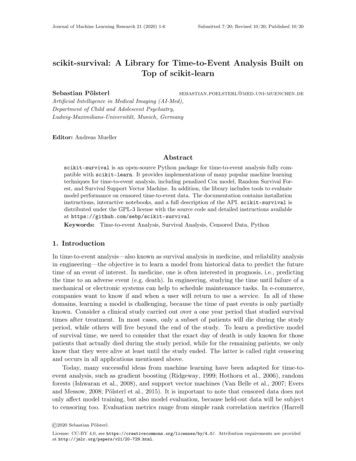
Transcription
Journal of Machine Learning Research 21 (2020) 1-6Submitted 7/20; Revised 10/20; Published 10/20scikit-survival: A Library for Time-to-Event Analysis Built onTop of scikit-learnSebastian tificial Intelligence in Medical Imaging (AI-Med),Department of Child and Adolescent Psychiatry,Ludwig-Maximilians-Universität, Munich, GermanyEditor: Andreas MuellerAbstractscikit-survival is an open-source Python package for time-to-event analysis fully compatible with scikit-learn. It provides implementations of many popular machine learningtechniques for time-to-event analysis, including penalized Cox model, Random Survival Forest, and Survival Support Vector Machine. In addition, the library includes tools to evaluatemodel performance on censored time-to-event data. The documentation contains installationinstructions, interactive notebooks, and a full description of the API. scikit-survival isdistributed under the GPL-3 license with the source code and detailed instructions availableat https://github.com/sebp/scikit-survivalKeywords: Time-to-event Analysis, Survival Analysis, Censored Data, Python1. IntroductionIn time-to-event analysis—also known as survival analysis in medicine, and reliability analysisin engineering—the objective is to learn a model from historical data to predict the futuretime of an event of interest. In medicine, one is often interested in prognosis, i.e., predictingthe time to an adverse event (e.g. death). In engineering, studying the time until failure of amechanical or electronic systems can help to schedule maintenance tasks. In e-commerce,companies want to know if and when a user will return to use a service. In all of thesedomains, learning a model is challenging, because the time of past events is only partiallyknown. Consider a clinical study carried out over a one year period that studied survivaltimes after treatment. In most cases, only a subset of patients will die during the studyperiod, while others will live beyond the end of the study. To learn a predictive modelof survival time, we need to consider that the exact day of death is only known for thosepatients that actually died during the study period, while for the remaining patients, we onlyknow that they were alive at least until the study ended. The latter is called right censoringand occurs in all applications mentioned above.Today, many successful ideas from machine learning have been adapted for time-toevent analysis, such as gradient boosting (Ridgeway, 1999; Hothorn et al., 2006), randomforests (Ishwaran et al., 2008), and support vector machines (Van Belle et al., 2007; Eversand Messow, 2008; Pölsterl et al., 2015). It is important to note that censored data does notonly affect model training, but also model evaluation, because held-out data will be subjectto censoring too. Evaluation metrics range from simple rank correlation metrics (Harrell 2020 Sebastian Pölsterl.License: CC-BY 4.0, see https://creativecommons.org/licenses/by/4.0/. Attribution requirements are providedat http://jmlr.org/papers/v21/20-729.html.
Pölsterlet al., 1996; Uno et al., 2011) to time-dependent versions of the well-known mean squarederror (Graf et al., 1999) and receiver operating characteristic curve (Hung and Chiang, 2010;Uno et al., 2007).In this paper, we present scikit-survival, a Python library for time-to-event analysis.It provides a tight integration with scikit-learn (Pedregosa et al., 2011), such that prepreprocessing and feature selection techniques within scikit-learn can be seamlesslycombined with a model from scikit-survival. It provides efficient implementations oflinear models, ensemble models, and survival support vector machines, as well as a range ofevaluation metrics suitable for right censored time-to-event data.2. Overview and DesignThe API of scikit-survival is designed to be compatible with the scikit-learn API,such that existing tools for cross validation, feature transformation, and model selectioncan be used for time-to-event analysis. Each model in scikit-survival is a sub-class ofscikit-learn’s BaseEstimator class, which offers users a familiar API to set hyper-parametersvia set params(), train a model via fit(), and evaluate it on held-out data via score().Time-to-event data is comprised of a time t 0 when an event occurred and the time c 0 ofcensoring. Since censoring and experiencing and event are mutually exclusive, it is commonto define a binary event indicator δ I(t c) {0; 1} and a observable time y t (if δ 1)or y c (if δ 0). To allow integration with scikit-learn, which expects a single array asdependent variable, scikit-survival uses numpy’s structured arrays, whose data type is acomposition of simpler data types. The sksurv.util.Surv utility helps users to create sucharrays from pandas DataFrames or individual numpy arrays.The biggest difference between time-to-event analysis and traditional machine learningtasks are the semantics of predictions. Predictions in time-to-event analysis are often arbitraryrisk scores of experiencing an event, and not an actual time of an event, which is the inputfor training such a model. Consequently, predictions are often evaluated by a measure ofrank correlation between predicted risk scores and observed time points in the test data. Forinstance, Harrell’s concordance index (Harrell et al., 1996) computes the ratio of correctlyordered (concordant) pairs to comparable pairs and is the default performance metric whencalling a model’s score() method. Models that provide time-dependent predictions in theform of survival function and cumulative hazard function, have two additional predictionmethods: predict survival function(), and predict cumulative hazard function().Such time-dependent predictions can be evaluated on held-out data using the time-dependentBrier score (Graf et al., 1999).3. DevelopmentWhere possible, scikit-survival uses scikit-learn’s efficient implementations to fit models.For instance, RandomSurvivalForest leverages scikit-learn’s Cython implementation to fittree-based estimators by introducing the log-rank node-splitting criterion for right censoreddata. Therefore, the computationally expensive training step usually runs natively, whichleads to high efficiency. To ensure high quality code, all implementations adhere to the PEP8code style, have inline documentation, and are accompanied by unit tests that are executed2
scikit-survival1234567import numpy as npimport matplotlib.pyplot as pltfrom sklearn.model selection import train test splitfrom sklearn.pipeline import make pipelinefrom sksurv.datasets import load whas500from sksurv.linear model import CoxPHSurvivalAnalysisfrom sksurv.preprocessing import OneHotEncoder8111213# load example datadata x, data y load whas500()# split the dataX train, X test, y train, y test train test split(data x, data y, test size 50, random state 2020)1415161718192021# combine feature transform and Cox modelpipeline make pipeline(OneHotEncoder(), CoxPHSurvivalAnalysis())# fit the modelpipeline.fit(X train, y train)# compute concordance index on held-out datac index pipeline.score(X test, y ance index 0.8081.0probability of survival Ŝ(t)910# plot estimated survival functionssurv fns pipeline.predict survival function(X test)time points np.arange(1, 1000)for surv func in surv fns:plt.step(time points, surv func(time points),where "post")plt.ylabel("probability of survival \hat{S}(t) ")plt.xlabel("time t ")plt.title("concordance index %.3f" % c index)plt.show()2004006008001000time tFigure 1: Example of using scikit-survival (left) and its output (right).on all supported platforms by our continuous integration workflow. As a result, units testscover 98% of our code, and code quality is rated A by Codacy.14. Installation and Usagescikit-survival is hosted on GitHub2 , interactive tutorials in the form of notebooks andAPI documentation are available on the Read the Docs platform.3 Pre-compiled packages forPython 3.6 and above are available for Linux, macOS, and Windows, and can be obtainedvia Anaconda using conda install -c sebp scikit-survival. Figure 1 shows a basicexample of fitting and evaluating a model in scikit-survival. More elaborate examplescan be found in the online documentation.1. https://www.codacy.com/app/sebp/scikit-survival2. https://github.com/sebp/scikit-survival3. https://scikit-survival.readthedocs.io/3
PölsterlTaskModelSurvival FunctionEstimationCHF rametricCoxCox Elastic-NetLog-normal AFTLog-logistic AFTWeibull AFTPiecewise exponentialAalenGradient Boosted AFTGradient Boosted CoxHeterogenous EnsembleNN (Grouped survival times)NN (Proportional hazards)NN (Piecewise exponential)Random Survival ForestSurvival SVMSurvival TreeBrier ScoreConcordance IndexTime-dependent ROCLinear RegressionNon-linear 7337777777777777777737773777737777333777337Table 1: Availability of methods. AFT: Accelerated Failure Time. CHF: Cumulative HazardFunction. NN: Neural Network. SVM: Support Vector Machine.5. Comparison to Related SoftwareThe R language currently offers many packages for time-to-event analysis. Usually, eachpackage focuses on a specific type of model, such as tree-based models, and API and codequality can vary widely across packages. Options for the Python scientific computing stackare currently limited. statsmodels (Seabold and Perktold, 2010) only has basic support; itincludes Cox’s proportional hazards models (Cox, 1972), the Kaplan-Meier estimator (Kaplanand Meier, 1958), and the log-rank test (Peto and Peto, 1972). Its API is not compatible withscikit-learn. The lifelines package (Davidson-Pilon et al., 2020) includes alternativeimplementations of those and additionally includes parametric estimators of the survivalfunction, additive, semi-parametric and parametric regression models. Recent versions alsoinclude an experimental compatibility layer for integration with the scikit-learn API.pycox (Kvamme et al., 2019) focuses on neural networks and provides losses for proportionalhazards, grouped survival time, and piecewise exponential models that can be minimizedby stochastic gradient descent. In contrast to the above, scikit-survival is designed tobe fully compatible with the scikit-learn API, includes traditional linear models, modernmachine learning models, and a range of evaluation metrics. Table 1 presents a detailedcomparison.4
scikit-survival6. Conclusionscikit-survival is a Python package that provides implementations of popular machinelearning models and evaluation metrics for time-to-event analysis. Thanks to its compatibilitywith the scikit-learn API, users can utilize existing tools for cross-validation and modelselection to create powerful analysis pipelines.ReferencesD. R. Cox. Regression models and life tables. Journal of the Royal Statistical Society: SeriesB, 34:187–220, 1972.C. Davidson-Pilon, J. Kalderstam, N. Jacobson, sean reed, B. Kuhn, P. Zivich, M. Williamson,AbdealiJK, D. Datta, A. Fiore-Gartland, A. Parij, D. WIlson, Gabriel, L. Moneda, K. Stark,A. Moncada-Torres, H. Gadgil, Jona, K. Singaravelan, L. Besson, M. S. Peña, S. Anton,A. Klintberg, J. Noorbakhsh, M. Begun, R. Kumar, S. Hussey, D. Golland, jlim13, andA. Flaxman. CamDavidsonPilon/lifelines. Zenodo, 2020. doi: 10.5281/zenodo.805993.L. Evers and C.-M. Messow. Sparse kernel methods for high-dimensional survival data.Bioinformatics, 24(14):1632–1638, 2008. doi: 10.1093/bioinformatics/btn253.E. Graf, C. Schmoor, W. Sauerbrei, and M. Schumacher. Assessment and comparison ofprognostic classification schemes for survival data. Statistics in Medicine, 18(17-18):2529–2545, 1999. doi: 10.1002/(SICI)1097-0258(19990915/30)18:17/18 2529::AID-SIM274 3.0.CO;2-5.F. E. Harrell, K. L. Lee, and D. B. Mark. Multivariable prognostic models: issues in developingmodels, evaluating assumptions and adequacy, and measuring and reducing errors. Statisticsin Medicine, 15(4):361–387, 1996. doi: 10.1002/(SICI)1097-0258(19960229)15:4 361::AID-SIM168 3.0.CO;2-4.T. Hothorn, P. Bühlmann, S. Dudoit, A. Molinaro, and M. J. van der Laan. Survivalensembles. Biostatistics, 7(3):355–373, 2006. doi: 10.1093/biostatistics/kxj011.H. Hung and C. T. Chiang. Estimation methods for time-dependent AUC models withsurvival data. Canadian Journal of Statistics, 38(1):8–26, 2010. doi: 10.1002/cjs.10046.H. Ishwaran, U. B. Kogalur, E. H. Blackstone, and M. S. Lauer. Random survival forests.The Annals of Applied Statistics, 2(3):841–860, 2008. doi: 10.1214/08-aoas169.E. L. Kaplan and P. Meier. Nonparametric Estimation from Incomplete Observations. Journalof the American Statistical Association, 53:457–481, 1958. doi: 10.2307/2281868.H. Kvamme, Ørnulf Borgan, and I. Scheel. Time-to-Event Prediction with Neural Networksand Cox Regression. Journal of Machine Learning Research, 20(129):1–30, 2019.F. Pedregosa, G. Varoquaux, A. Gramfort, V. Michel, B. Thirion, O. Grisel, M. Blondel, P. Prettenhofer, R. Weiss, V. Dubourg, J. Vanderplas, A. Passos, D. Cournapeau,M. Brucher, M. Perrot, and E. Duchesnay. Scikit-learn: Machine Learning in Python.Journal of Machine Learning Research, 12:2825–2830, 2011.5
PölsterlR. Peto and J. Peto. Asymptotically Efficient Rank Invariant Procedures. Journal of theRoyal Statistical Society: Series A, 135(2):185–207, 1972. doi: 10.2307/2344317.S. Pölsterl, N. Navab, and A. Katouzian. Fast Training of Support Vector Machines forSurvival Analysis. In A. Appice, P. P. Rodrigues, V. Santos Costa, J. Gama, A. Jorge,and C. Soares, editors, Machine Learning and Knowledge Discovery in Databases, LectureNotes in Computer Science, pages 243–259, 2015. doi: 10.1007/978-3-319-23525-7 15.G. Ridgeway. The state of boosting. Computing Science and Statistics, pages 172–181, 1999.S. Seabold and J. Perktold. statsmodels: Econometric and statistical modeling with python.In 9th Python in Science Conference, 2010.H. Uno, T. Cai, L. Tian, and L. J. Wei. Evaluating Prediction Rules for t-Year SurvivorsWith Censored Regression Models. Journal of the American Statistical Association, 102:527–537, 2007. doi: 10.1198/016214507000000149.H. Uno, T. Cai, M. J. Pencina, R. B. D’Agostino, and L. J. Wei. On the C-statistics forevaluating overall adequacy of risk prediction procedures with censored survival data.Statistics in Medicine, 30(10):1105–1117, 2011. doi: 10.1002/sim.4154.V. Van Belle, K. Pelckmans, J. A. K. Suykens, and S. Van Huffel. Support Vector Machinesfor Survival Analysis. In Proc. of the 3rd International Conference on ComputationalIntelligence in Medicine and Healthcare, pages 1–8, 2007.6
scikit-survival is an open-source Python package for time-to-event analysis fully com-patible with scikit-learn. It provides implementations of many popular machine learning techniques for time-to-event analysis, including penalized Cox model, Random Survival For-est, and Survival Support Vector Machine.
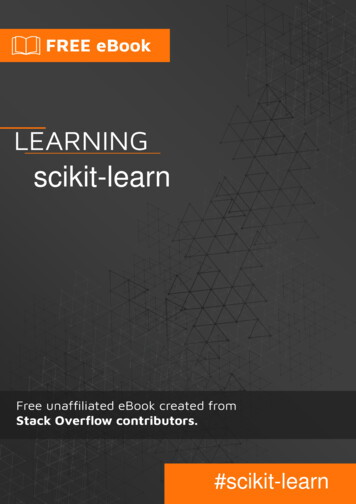

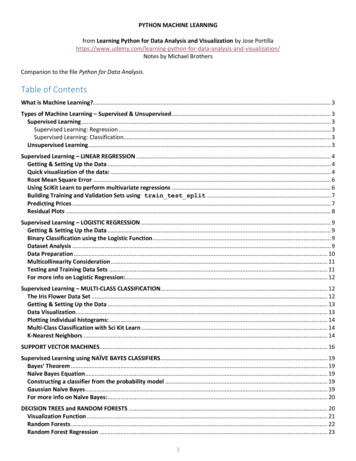
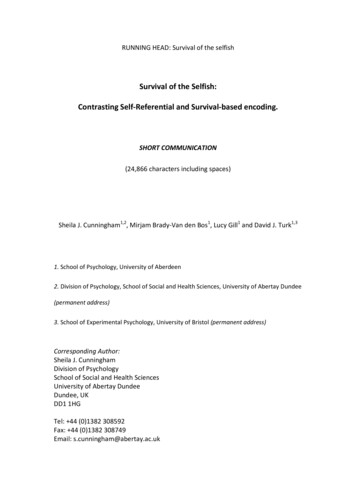



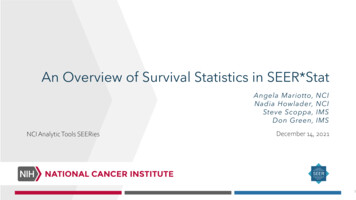

![[ST] Survival Analysis - Stata](/img/33/st.jpg)
